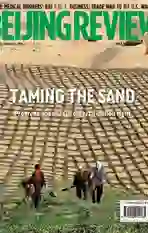Replicating the Kubuqi’s Success
2018-09-19
In north Chinas Inner Mongolia Autonomous Region, there lies a desert by the name of Kubuqi. Three decades ago, it was a barren place, but today this desolation has been replaced by an idyllic scene of plentiful fl ora and greenery. This is not a legend, but a successful example of Chinas fight against desertifi cation, and possibly the only example of success in transforming desert into oasis thus far in the world.
The Kubuqi was once Chinas seventh largest desert. Yet the levels of forestation and green coverage in the region jumped from 0.8 and 16.2 percent in 2002 to 15.7 and 53 percent in 2016. Years of hard work have borne fruit, and this miracle shows that desertifi cation is in fact reversible.
Desertification is a major problem for China, with the northern and western parts of the country covered by large swathes of desert. The Chinese Government thus attaches great importance to the fight against desertifi cation. In 2002, the central authority released the worlds fi rst comprehensive legal regulation on the prevention and treatment of desertifi cation in a bid to reinforce the countrys efforts to cope with the challenges posed by the degradation of its land. The government also invested heavily in afforestation and sand break projects. The victory over desertification in the Kubuqi showcases Chinas expertise and the maturity of its programs to contain the spread of deserts.
The techniques used to control desertifi -cation in the Kubuqi have been successfully replicated and exported to countries involved in the Belt and Road Initiative.
The changes that have taken place in the Kubuqi over the past three decades also won recognition from international observers at the 2018 UN High-Level Political Forum on Sustainable Development. The Kubuqi has also been designated a “global desert ecological economy demonstration zone” by the UN Development Program.
The replication and widespread use of the Kubuqi model is an example of Chinese wisdom and experience contributing to the sustainable development of the world and to the UNs goal for the zero growth of land degradation by 2030.
It is hoped that the positive changes taking place in the Kubuqi can be reproduced in more deserts around the world, so that more people can enjoy the happiness brought by green mountains and clear water in the places they call home.
